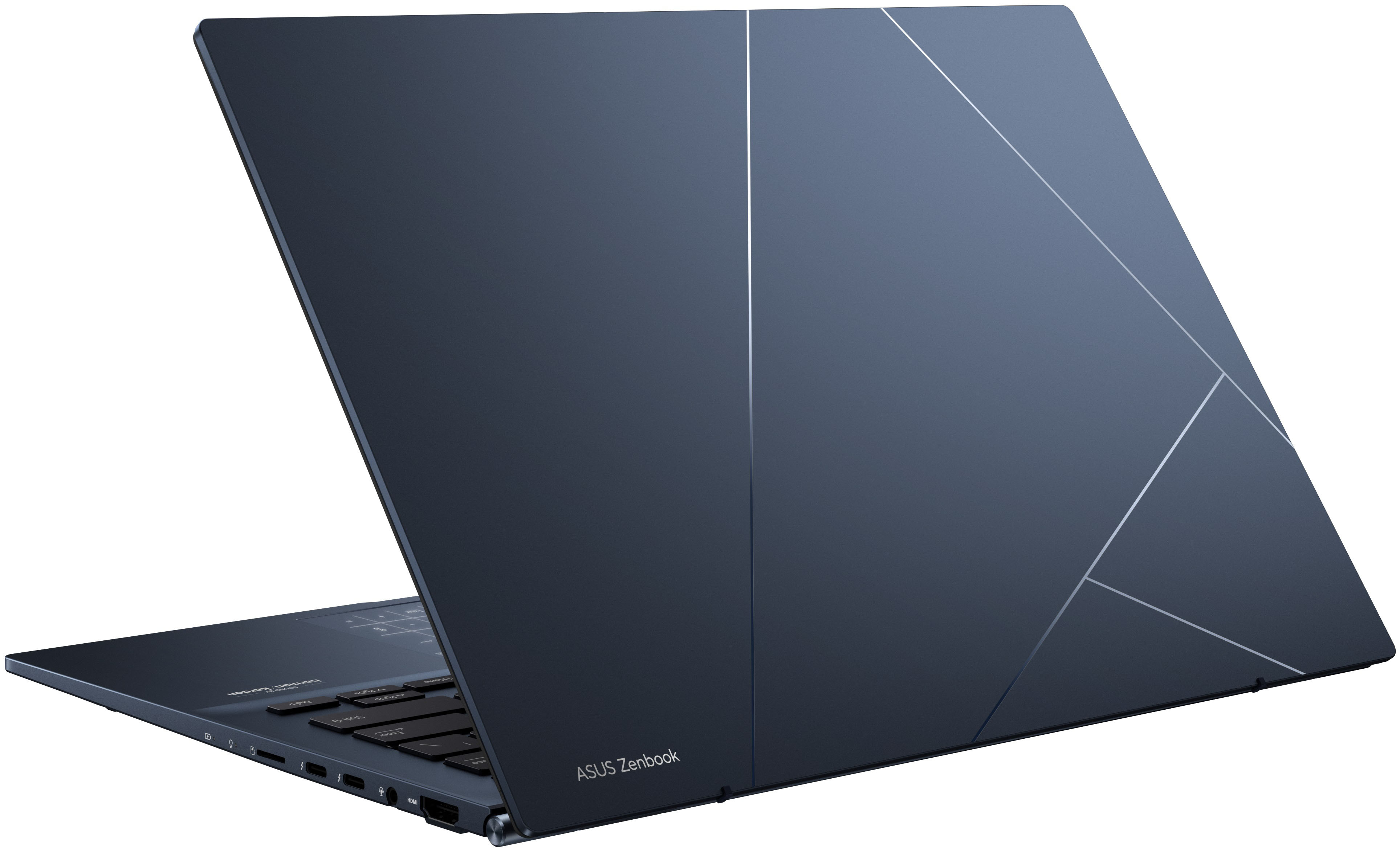Building a worthwhile mid-range or budget product is an art in compromise, choosing where to make cuts in order to shave more off the price tag. It's arguably harder to do than shoving everything you can find inside a super-premium, ultra-expensive device, but ASUS has almost entirely nailed the experience with the ASUS Zenbook 14 (Q415M), a thin and light Ultrabook retailing for just $800.
A solidly built aluminum chassis, a comfortable backlit keyboard, a genuinely wonderful touch-enabled OLED display, and Intel Core Ultra under the hood make this a fantastic laptop for a huge number of people, especially for the price. However, there is one limitation that will be a hard stop for some — there's only 8GB of RAM on board, and it can't be upgraded after you purchase the laptop, and you can hit that limit easily if you frequently have lots of apps and browser tabs open.
The ASUS Zenbook 14 (Q415M) only comes in one configuration, which sports an Intel Core Ultra 5 125H (sorry, no Intel Core Ultra Series 2 here) with 8GB of nonupgradeable RAM and a 512GB SSD. It's a decent setup, especially when paired with the attractive aluminum chassis and OLED touch display. For those who are concerned about that RAM, though, there is a Q425M that is almost entirely identical, but does boast some upgrades.
The ASUS Zenbook 14 (Q425M) is powered by an Intel Core Ultra 7, 16GB of RAM, and a 1TB SSD. It's the same design and the same OLED display, too, but its price tag isn't quite as appealing as its more affordable sibling. The Zenbook 14 (Q415M) retails for a cool $799.99 at Best Buy, and is honestly an excellent deal at that price. The Q425M model costs an extra $250 for its upgrades, retailing for $1,049.99 at Best Buy. This is still an excellent option, but breaking that $1,000 barrier is going to deter some buyers.
Design and Build Quality
One of the first compromises many companies make when cutting costs is design and build quality. After all, you want your more premium products to stand out, right? The ASUS Zenbook 14 (Q415M) is clearly a step below ASUS' best, but the design is surprisingly premium and well-constructed considering the $800 price tag. The entire chassis and lid are aluminum, with an all-glass display and touchpad.
At just 15mm thick and less than three pounds, this is a very slim and light 14-inch laptop that feels reliable. Sure, you can find some flexing in the chassis (specifically around the speaker grilles and the center of the keyboard deck) and some creaks that you wouldn't expect in a $2,000 laptop, but I don't have any concern that the Zenbook 14 (Q415M) would fall apart over time. Visually the design is on the basic side, but ASUS didn't skimp on the materials, build quality, or practicality.
That last point is because the ASUS Zenbook 14 (Q415M) actually has a solid port selection. You get a legacy USB Type A 3.2 Gen 1 port on the left side, and two full-blown USB Type-C Thunderbolt 4 ports, a 3.5mm audio jack, and even a full-sized HDMI 2.1 port on the right side. Oh, and there are two LED indicators on the right side, too. I wish one of those Thunderbolt 4 ports was also on the left, but that's a very minor qualm.
Display Quality
It's no secret that I love the vibrant colors of a good OLED display, but simply using the tech isn't enough on its own. Fortunately, ASUS is one of the most consistent companies when it comes to using OLED panels in its laptops, with its “Lumina” and “NanoEdge” branding basically translating to better color accuracy and thinner bezels.
ASUS once again proves its expertise with the ASUS Zenbook 14 (Q415M), where that OLED panel is one of the best parts of this laptop. It's not the highest resolution at FHD+ and I would've preferred a 90-120Hz dynamic refresh rate, but I can't complain much about either of those things when this laptop costs $800 and comfortably beats basically anything else in the category on pure image quality.
This screen is more than bright enough for comfortable use, with the normal max brightness approaching 400nits; when you need to turn things down, the Q415M gets very dim. The white balance is consistent across the board, too, with a slightly cool tone that slowly gets slightly warmer as you go up in brightness. Basically, this display looks phenomenal at every brightness level, with vibrant and saturated colors. I never once thought the FHD+ resolution was an issue.
Color accuracy is where this display really excels, however, easily hitting 100% of the sRGB and DCI-P3 color gamuts out of the box. ASUS bakes in a ton of display-centric features into the MyASUS apps, like different display modes coded to specific color gamuts and blue light emission reduction, but the default is basically perfect. MyASUS also includes several protective features like pixel shifting to help prevent any damage to the OLED display over time like burn-in from static images, and ASUS has a good track record here.
Performance and Thermals
The ASUS Zenbook 14 (Q415M) doesn't impress on paper, and it's certainly not equipped to handle heavy-duty computing tasks like gaming or creative work. However, it is perfectly suited for the exact people this laptop is aimed at and their workflow. The Intel Core Ultra 5 125H under the hood ensures this laptop feels snappy and responsive for casual work, and can kick it up a notch when you need it.
This is still an Intel Evo certified laptop, meaning it comes with certain guarantees on boot up, wake up, and log in speeds, efficiency, performance, and security. It's not an absolute that you'll find those assurances at this price point, and the Q415M does deliver. Running Windows 11, it feels perfectly fast opening apps, moving files around, browsing the web, and more.
It does have one weakness, though... 8GB of non-upgradable, soldered RAM is fine for light work, but you do notice those limitations once you start opening more apps and browser tabs, and begin moving those windows around. I couldn't even run Cinebench 2024, one of the benchmarks Windows Central uses in our testing, because of that limitation. It doesn't ruin this laptop, but it does limit it.
Speaking of benchmarks, the Q415M performs well in the tests I was able to run. The Intel Core Ultra 5 is very competitive with the new Qualcomm Snapdragon X Plus inside devices like the ASUS ProArt PZ13. Despite the SSD being on the slower end of PCIe Gen 4.0 drives, the limited 8GB of RAM, and the mid-range processor, the Zenbook 14 (Q415M) keeps up with more expensive laptops in general productivity and even casual gaming.
I was surprised by the latter, as this laptop technically doesn't have the upgraded Intel Arc integrated graphics (which requires 16GB or more RAM). Still, this laptop is comparable in GPU performance to a gaming handheld like the ASUS ROG Ally, which is impressive; that being said, don't expect it to actually play games at the same level.
Finally, thermal performance is very good. The fans are quiet and rarely kick on, and when you hear them spin up they do an excellent job keeping the Q415M cool. This helps the Core Ultra 5 compete with the beefier Core Ultra 7 inside hotter laptops.
Battery Experience
With an Intel Core Ultra 5 and a large 75Whr battery, I expected the ASUS Zenbook 14 (Q415M) to boast stellar endurance. It doesn't quite achieve that status, falling short of the recent wave of Windows on ARM devices, but this laptop still has reliable and consistent battery life good enough to last a full day of school or work, and that's what matters most.
In the benchmark app Procyon, I ran the Q415M through a simulated Microsoft Office workflow for an hour at approximately 200nits brightness, and it went through 9% of its battery. Looping an HD video at 50% volume through Procyon saw a 10% loss (an unexpected result, but the speakers could be more power hungry than I expected). My personal real-world experience, which I verified with Windows Battery Report, showed a consistent screen-on runtime of 6-10 hours, depending on the intensity of my workflow.
That's already good enough to make it through your average day of work if you're using the laptop constantly, and that's without turning any settings like the keyboard backlighting or performance down. Charging is quick and easy, too, with 65W USB Type-C charging on board.
Everything Else
Now that we've gotten all the major categories out of the way, let's wrap things up. You usually shouldn't expect too much from the keyboard and touchpad combo on a budget or mid-range laptop, but the Zenbook 14 (Q415M) is different. This keyboard is comfortable, well laid out, and feels great to type on. Keyboard backlighting isn't the most even, but it's at least here, and that's great to see.
The glass touchpad does use Microsoft Precision drivers with full multitouch gesture support, and the nice large surface and satisfying buttons make it a joy to use. Well, except for when the touchpad occasionally registers a second tap, which has resulted in me accidentally opening up a second new tab, opened the right-click menu when I meant to scroll, and more. It's not a major issue, but this touchpad is a little too sensitive.
Elsewhere, the FHD webcam is nothing to write home about, but it boasts solid color reproduction and performs decently in low-light scenarios, even if it quickly loses a lot of detail. At the very least, Windows Hello biometric authentication is here with facial recognition support; while not quite as quick or reliable as more expensive laptops, it's still a lot better than typing in a PIN or password every time. Another great feature to see at this price point.
Wi-Fi 6E and Bluetooth 5.3 support deal with all your wireless connectivity woes, and I had zero issues with performance or stability. The dual speakers, which are apparently tuned by Harman Kardon and support Dolby Atmos, also punch slightly above their weight in this price range. I never expected the kind of excellent audio quality you can get with other laptops like the ASUS ROG Zephyrus G14 (2024), but these speakers get shockingly loud and sound surprisingly clear and detailed. Above average (but not exceptional) audio is another win for $800.
Finally, the Zenbook 14 (Q415M) does run Windows 11, of course, and ASUS continues to be offer one of my favorite software experiences. There are next to no preinstalled apps beyond the usual handful of ASUS, Intel, and audio apps (McAfee is nowhere in sight, thank goodness), and MyASUS is an excellent software hub for managing the Q415M's settings and firmware. It's worth mentioning, though, that because this laptop is powered by Intel Core Ultra Series 1 it will not be eligible to become a Copilot+ AI PC later this year.
Competition
There's no shortage of laptops in the sub-$1,000 range from companies like Dell, HP, Lenovo, ASUS, Acer, and others. Right now and in my personal experience, I'd give the edge in the category to Lenovo and ASUS, though, and in particular the biggest direct competition for this laptop is... another Zenbook.
The ASUS Zenbook 14 (UM3406) is very similar to the Q415M, including the same starting price of $800, except it swaps out Intel for AMD and adds an extra 8GB of RAM. That latter point could make all the difference if you're trying to choose, but you honestly can't go wrong with either.
There's always the ASUS Zenbook 14 (Q425M), too, which is basically this laptop but $250 more expensive, with twice the RAM and SSD storage and a more powerful CPU and GPU. If you're spending that much, though, it's worth considering the Lenovo Slim 7i 14 (Gen 9), which is a brilliant laptop in that $1,000 range.
I'd be remiss if I didn't point out that the greatest alternatives to the Q415M may just barely be arriving on the market. Qualcomm's new 8-core Snapdragon X Plus has opened the door for performant and ultra-efficient PCs to break the $8-900 barrier, which means laptops like the Lenovo IdeaPad 5x 14 2-in-1 (Gen 9) are about to be very tempting. If you just need a really good, long-lasting laptop for casual browsing, it's worth looking into.
Scorecard and Final Thoughts
It's always interesting to review budget and mid-range laptops when you're used to the most premium and expensive devices, as companies have different philosophies when it comes to compromising and cost-cutting. With the ASUS Zenbook 14 (Q415M), it's about delivering a reliable and quality experience across the board for well under $1,000, and ASUS frankly nailed it.
This is a lovely 14-inch Ultrabook with great build quality, a solid port selection, consistent performance, and dependable battery life. The OLED touch display is well above average for the price range, too, comfortably besting the screens in more expensive laptops. There's no area where the Q415M flat out falls short, but that doesn't mean it's perfect. Just one small change would've made a world of difference... and that's more RAM.
With Microsoft Edge and around 10 tabs, Outlook, Slack, Sticky Notes, and the Photos app, I start to see performance take a steep dive on the Zenbook 14 (Q415M), and that's solely because of the limits of 8GB of RAM. 16GB should honestly be the default in this day and age, but that weakness still isn't enough to write off the Q415M. Most casual users will be fine, and ASUS is aiming at these consumers with this laptop. When the ASUS Zenbook 14 (Q415M) costs just $799.99 at Best Buy, it's easy to see the appeal.
With the beautiful, 14-inch OLED touch display headlining, the Zenbook 14 (Q415M) easily justifies its $800 asking price, making it one of the best values for those who need a dependable laptop for casual use that still boasts some added features and luxuries. Just mind the RAM.


















